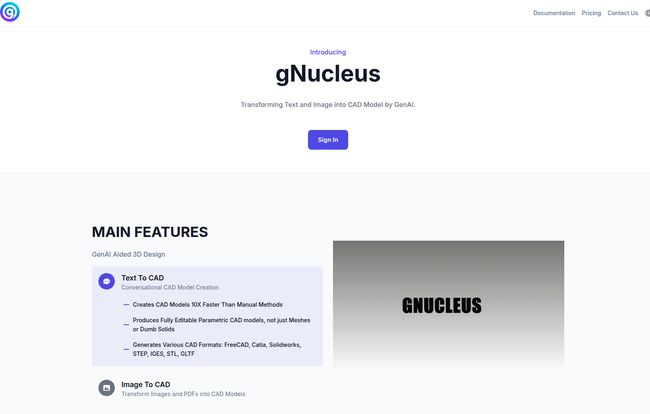I’ve been in the digital space for a long time. Long enough to remember when 'cloud computing' was a fuzzy concept and SEO was basically just stuffing keywords into your footer. So, when a new tool comes along promising to change the game, my default setting is a healthy, battle-worn skepticism. But every now and then, something pops up on my radar that makes even a cynic like me sit up and pay attention. Today, that something is called gNucleus.
The pitch is simple, almost deceptively so: Transform text and images into CAD models. Not just static meshes or the ‘dumb solids’ that are a nightmare to edit. We're talking fully editable, parametric CAD models. If you've ever spent a week meticulously modeling a complex assembly, you know why that sentence just gave me goosebumps.

Visit gNucleus
So, What is gNucleus Anyway?
Let's get this straight. gNucleus isn't another Midjourney for creating pretty, but ultimately flat, pictures. This is different. It’s powered by Generative AI, or GenAI, and it's built for people who actually make things. Engineers, product designers, architects, and maybe even advanced hobbyists. The core idea is to bridge the gap between human language and the structured, mathematical world of Computer-Aided Design (CAD).
Think of it like this: traditional CAD modeling is like building a complex Lego castle one tiny brick at a time. You have to place every single piece perfectly. gNucleus is more like describing the castle you want to an expert Lego builder—'a four-towered fortress with a drawbridge and crenelated walls'—and having them build a solid foundation for you in minutes. You can then go in and tweak the details. That’s the dream, right?
The Features That Actually Matter
A features list can be boring, I get it. But with gNucleus, the features are the whole story. Let’s break down what actually caught my eye.
From a Simple Prompt to a 3D Model
This is the headline act: Text to CAD. You type a description, and it generates a model. The platform claims to create fully parametric models. This is the part that’s so critical. A parametric model means you can change a single dimension—say, the diameter of a bolt hole—and the rest of the model intelligently updates. It’s the difference between a sculpture carved from stone and one made from clay. One is fixed forever; the other is ready to be reshaped. This alone could be a massive workflow accelerator.
Turning Your 2D Inspiration into 3D Reality
Next up is Image to CAD. We’ve all been there. You see a sketch, a photo of an old part, or a diagram in a PDF and think, “I need to model that.” The usual process involves importing the image, tracing it, and slowly building it up in 3D. gNucleus aims to automate that. Feed it an image, and it spits out a 3D model. The potential for reverse engineering or rapid prototyping from a simple concept sketch is just... wow.
Let's Talk About Assemblies
Okay, this is where my jaw really dropped. gNucleus claims to support Assembly Generation from text, spreadsheets, PDFs, and even Bills of Materials (BOMs). Anyone who has ever manually assembled 50 different components in a CAD environment, setting up all the mates and constraints, knows that it is tedious, soul-crushing work. If this AI can take a BOM spreadsheet and generate a complete, or even a partially-complete, assembly... that’s not just a 10x speed increase. That’s giving you back entire days of your life.
Why I’m Genuinely Excited (and a Little Cautious)
The promise of a 10x speed boost is a bold claim, but frankly, I believe it’s possible. The real value isn’t just in doing the same work faster, but in enabling a more creative and iterative design process. When you can generate a dozen concepts in the time it used to take to model one, your final product is bound to be better.
Another huge plus is the multi-format support. A tool is useless if it traps you in its own ecosystem. According to their site, gNucleus plays nice with the big names:
| Supported CAD Formats |
|---|
| FreeCAD |
| Catia |
| Solidworks |
| STEP |
| IGES |
| STL, GLTF |
That level of interoperability is non-negotiable for professionals.
"It's not just about speed; it's about reducing friction between an idea and its physical realization. That's the holy grail of design technology."
But, lets pump the brakes a little. My skeptical side has to chime in. The output quality is entirely dependent on two things: the sophistication of their GenAI and the quality of your prompt. The old mantra of 'garbage in, garbage out' will likely apply here more than ever. Learning to 'speak' the AI's language to get the optimal result—a process we're all now calling prompt engineering—will be a skill in itself. I expect the first few tries for any user will be a mix of amazement and hilarious failure.
The Elephant in the Room: gNucleus Pricing
So, how much does this magic cost? Great question. I went looking for a pricing page, clicked the link, and... was greeted by a 404 error page. You gotta love the honesty of a 'page not found' when you're looking for a price list. It tells a story in itself.
My guess? They're still figuring it out. This technology is brand new, and finding the right pricing model is tough. Will it be a monthly subscription like Adobe? A pay-per-generation model? Or maybe a tiered system based on complexity? For now, your guess is as good as mine. The lack of a price tag suggests gNucleus is either in an early beta phase or they're still gauging market interest before putting a number on it. It’s something to keep an eye on, for sure.
Who Is This Tool Really For?
While it might be marketed as 'easy and fun,' the real power of gNucleus seems aimed squarely at professionals. The emphasis on parametric models and assembly generation from BOMs isn't for the casual user printing keychains on their Ender 3. This is for:
- Product Development Teams looking to speed up initial prototyping.
- Mechanical Engineers who need to model complex parts and assemblies.
- Architects and Industrial Designers who want to quickly visualize concepts in 3D.
- Students and Educators in STEM fields who can use it as a powerful learning and teaching aid.
The 'fun' part is a bonus, but the efficiency gains are the real selling point for any business looking at their bottom line.
Frequently Asked Questions
I've been getting some DMs about this, so here are some quick answers.
What exactly is gNucleus?
gNucleus is a software platform that uses Generative AI to create 3D CAD models from text descriptions and 2D images. It's designed to speed up the design and modeling process significantly.
How is gNucleus different from other AI model generators?
The main difference is its output. Instead of creating simple meshes or static 3D files (like STL), gNucleus aims to produce parametric CAD models. This means the models are fully editable in professional CAD software, a huge advantage for engineering and design.
What CAD formats does gNucleus support?
It supports a wide range of popular formats, including Solidworks, Catia, FreeCAD, as well as universal formats like STEP, IGES, STL, and GLTF.
Can I actually edit the models gNucleus creates?
Yes. This is one of its main selling points. Because it generates parametric models, you can open them in compatible software and modify dimensions, features, and constraints.
Is gNucleus free?
The pricing information isn't public yet. The pricing page on their website currently leads to an error, which suggests they are in an early stage and haven't finalized a pricing structure.
How does the assembly generation work?
It can take various inputs like a text description of the assembly, a spreadsheet, a PDF file, or a Bill of Materials (BOM) to automatically generate a 3D assembly of multiple components.
Final Thoughts: Is gNucleus the Future or Just a Fad?
Look, I've seen a lot of tools flash and fizzle out. But this one feels different. The problems gNucleus is trying to solve are not trivial; they are fundamental pain points in the design and engineering world. The move from manual, click-by-click modeling to conversational, intent-based design feels... inevitable.
Will gNucleus be the tool that perfects it? Maybe. Maybe not. It will have bugs, limitations, and a learning curve. But it represents a massive step in the right direction. It's a sign that the AI revolution isn't just about writing emails or making funky art—it's coming for the hard stuff, the industrial stuff. And I, for one, am here for it. I'll be watching this one closely. Very closely.
Reference and Sources
- The Official gNucleus Website: https://www.gnucleus.com/



